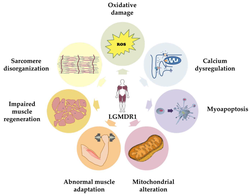Calpainopathy

Editor-In-Chief: Prab R Tumpati, MD
Obesity, Sleep & Internal medicine
Founder, WikiMD Wellnesspedia &
W8MD medical weight loss NYC and sleep center NYC
| Calpainopathy | |
|---|---|

| |
| Synonyms | Limb-girdle muscular dystrophy type 2A (LGMD2A) |
| Pronounce | |
| Specialty | Neurology, Genetics |
| Symptoms | Muscle weakness, especially in the pelvic girdle and shoulder girdle |
| Complications | N/A |
| Onset | Typically in childhood or adolescence |
| Duration | Chronic |
| Types | N/A |
| Causes | Mutations in the CAPN3 gene |
| Risks | Genetic predisposition |
| Diagnosis | Genetic testing, muscle biopsy |
| Differential diagnosis | Other forms of limb-girdle muscular dystrophy |
| Prevention | N/A |
| Treatment | Physical therapy, occupational therapy, orthopedic devices |
| Medication | No specific medication, supportive care |
| Prognosis | Variable, progressive muscle weakness |
| Frequency | Rare |
| Deaths | Not directly life-threatening, but complications can arise |
Calpainopathy is a genetic muscular dystrophy characterized by progressive muscle weakness and degeneration. It is caused by mutations in the CAPN3 gene, which encodes the enzyme calpain-3. Calpain-3 is a calcium-activated protease that plays a crucial role in muscle fiber maintenance and repair. The absence or malfunction of this enzyme due to genetic mutations leads to the symptoms associated with calpainopathy. This condition is also known as Limb-Girdle Muscular Dystrophy Type 2A (LGMD2A).
Symptoms and Diagnosis[edit]
The primary symptoms of calpainopathy include muscle weakness and atrophy, particularly affecting the shoulder and pelvic girdles. The onset of symptoms usually occurs in late childhood or adolescence, but can vary widely among individuals. As the disease progresses, patients may experience difficulty walking, climbing stairs, and performing tasks that require upper body strength. Respiratory and cardiac muscles can also be affected in later stages of the disease. Diagnosis of calpainopathy is based on clinical examination, family history, and genetic testing to identify mutations in the CAPN3 gene. Muscle biopsy and Creatine Kinase (CK) levels in the blood may also be used to support the diagnosis, as individuals with calpainopathy often have elevated CK levels due to muscle damage.
Treatment and Management[edit]
There is currently no cure for calpainopathy, and treatment focuses on managing symptoms and improving quality of life. Physical therapy and occupational therapy can help maintain muscle strength and flexibility, and assistive devices may be used to aid mobility. Regular cardiac and respiratory assessments are important to monitor the involvement of heart and lung muscles and initiate treatment for any complications.
Genetics[edit]
Calpainopathy is inherited in an autosomal recessive manner, meaning that an individual must inherit two copies of the mutated gene, one from each parent, to be affected by the disease. Carriers of one mutated gene typically do not show symptoms. The CAPN3 gene mutations that cause calpainopathy lead to a deficiency or dysfunction of the calpain-3 protein, disrupting normal muscle maintenance and repair processes.
Research and Future Directions[edit]
Research on calpainopathy is focused on understanding the precise role of calpain-3 in muscle function, developing gene therapies to replace or repair the defective gene, and finding ways to enhance muscle repair and regeneration. Clinical trials for potential treatments, including gene therapy and drugs that modulate muscle growth and repair, are ongoing.
Calpainopathy gallery[edit]
-
Pathophysiology of Calpainopathy
-
Structure related to Calpainopathy
-
Muscle Biopsy in Calpainopathy
See Also[edit]
Ad. Transform your life with W8MD's Budget GLP-1 injections from $75


W8MD offers a medical weight loss program to lose weight in Philadelphia. Our physician-supervised medical weight loss provides:
- Weight loss injections in NYC (generic and brand names):
- Zepbound / Mounjaro, Wegovy / Ozempic, Saxenda
- Most insurances accepted or discounted self-pay rates. We will obtain insurance prior authorizations if needed.
- Generic GLP1 weight loss injections from $75 for the starting dose.
- Also offer prescription weight loss medications including Phentermine, Qsymia, Diethylpropion, Contrave etc.
NYC weight loss doctor appointmentsNYC weight loss doctor appointments
Start your NYC weight loss journey today at our NYC medical weight loss and Philadelphia medical weight loss clinics.
- Call 718-946-5500 to lose weight in NYC or for medical weight loss in Philadelphia 215-676-2334.
- Tags:NYC medical weight loss, Philadelphia lose weight Zepbound NYC, Budget GLP1 weight loss injections, Wegovy Philadelphia, Wegovy NYC, Philadelphia medical weight loss, Brookly weight loss and Wegovy NYC
|
WikiMD's Wellness Encyclopedia |
| Let Food Be Thy Medicine Medicine Thy Food - Hippocrates |
Medical Disclaimer: WikiMD is not a substitute for professional medical advice. The information on WikiMD is provided as an information resource only, may be incorrect, outdated or misleading, and is not to be used or relied on for any diagnostic or treatment purposes. Please consult your health care provider before making any healthcare decisions or for guidance about a specific medical condition. WikiMD expressly disclaims responsibility, and shall have no liability, for any damages, loss, injury, or liability whatsoever suffered as a result of your reliance on the information contained in this site. By visiting this site you agree to the foregoing terms and conditions, which may from time to time be changed or supplemented by WikiMD. If you do not agree to the foregoing terms and conditions, you should not enter or use this site. See full disclaimer.
Credits:Most images are courtesy of Wikimedia commons, and templates, categories Wikipedia, licensed under CC BY SA or similar.
Translate this page: - East Asian
中文,
日本,
한국어,
South Asian
हिन्दी,
தமிழ்,
తెలుగు,
Urdu,
ಕನ್ನಡ,
Southeast Asian
Indonesian,
Vietnamese,
Thai,
မြန်မာဘာသာ,
বাংলা
European
español,
Deutsch,
français,
Greek,
português do Brasil,
polski,
română,
русский,
Nederlands,
norsk,
svenska,
suomi,
Italian
Middle Eastern & African
عربى,
Turkish,
Persian,
Hebrew,
Afrikaans,
isiZulu,
Kiswahili,
Other
Bulgarian,
Hungarian,
Czech,
Swedish,
മലയാളം,
मराठी,
ਪੰਜਾਬੀ,
ગુજરાતી,
Portuguese,
Ukrainian

